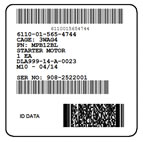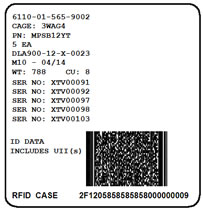Mil-Std-129R Solutions
Need to know more about labeling?
Mil-Std-129 Compliance Guide.
Comply/Labeling supports a wide range of Mil-Std-129R label formats:
- Labeling Unit and Exterior containers
- Military Shipment Labels (MSL)
- UID Container labels with 2D PDF417 symbols
- Barcoded Serial Number Lists for containers with 5+ IUIDs or SNs
- RFID-enabled labels
See examples of label formats generated by Comply/Labeling.
MIL-Comply Labeling is a robust standalone solution for Mil-Std-129R labeling. But it is also integrated with many of the other requirements faced by defense contractors making MIL-Comply a powerful solution for both single users and enterprise-sized teams that need to do:
- WAWF Receiving Report (DD250) / Combo transactions
- VSM Automation (for DLA Vendor Shipment Module)
- GFP Container Labeling (for shipping UID-marked Government Furnished Property)
- GSA Order Automation for shipping to DLA depots (in addition to Fed-Std-123)
- Automated RFID Labeling (from import data files)
- Automated Container Labeling from IUID Item Scanning
Linear Barcodes vs 2D Symbols for Mil-Std-129 Labels
The use of linear bar codes on defense shipment containers goes back to the LOGMARS standard, which was leading edge in the 1980s. Linear bar codes have, and continue to, serve an important purpose. And just like the linear UPC labels found on everything we buy in the private sector, they may continue to serve a purpose.
The downside of linear barcodes, at least with their traditional Mil-Std-129 use is that they require context in order to be useful to automated systems. At one point, MS-129 Revision P required up to nine linear barcodes on a package (that contained five serialized items). Designing automated systems to process such a label depends on reading them in the right order or recognizing the characteristics of the data (number of digits in an NSN versus a contract number).
The advantage of the PDF417 symbol is that encoded data is laid out in a specified data structure, each prefixed by a standardized Data Identifier.
The downside of PDF417 is that requires more complex, sensitive and expensive scanners than linear barcodes, along with software that can extract the desired data from the complex data of a 2D symbol. Comply/Labeling offers formats with linear barcodes and/or 2D symbols to meet your customer's requirements.
RFID Container Labels
Printing RFID labels is pretty easy. The challenge is collecting and organizing the data describing the contents, starting with the CLIN and quantity. And if there are IUIDs in the box, all of those must be associated with the RF Tag, along with the pallet each container is placed on. All of this data must be submitted to Wide Area Workflow (WAWF). MIL-Comply does all of that automatically, and can submit in an EDI Receiving Report (DD250) or Pack Update.
Mil-Std-129R defines the technical requirements for compliance with the DoD RFID Mandate. It also talks to how RF Tags should be deployed on containers. However, it falls short of defining what an RFID label should look like, primarily because there is no requirement for any visible indication that containers are RFID tagged. Tags may be integrated into the Military Shipment Label, Exterior Container Label or a Generic RFID label, or simply stuck on the box (usually under a label for protection).
More information is available: RFID in the DoD supply chain and Mil-Std RFID Labeling.
IUID Part Mark Labels
Item Unique Identification (IUID) marking of items is controlled by Mil-Std-130. While that specific task is entirely separate compliance container labeling, the Unique Item Identifiers (UII) themselves are central to a system that performs container marking because Mil-Std-129 compliance requires that UIIs appear on both the Unit Container and Exterior Container Labels. If more than five UID items are in a container, the UIIs must appear on a Barcoded Serial Number List.
When UID shipping containers are RFID-tagged the UIIs must be associated with the RF tag of their container. This information and the UIIs themselves have to be submitted to Wide Area Workflow (WAWF). All of this makes a case for a company's Mil-Std-129 labeling system to either drive IUID part marking, or have efficient methods of inputting or collecting them.
VSM Automation
The DLA Vendor Shipment Module website provides Transportation Control Numbers (TCN) and Shipping Addresses to defense contractors, as well as small parcel (e.g. UPS and FedEx) labels and GBLs. For contractors with higher volumes needing a more efficient process, DLA provides VSM automation through web services. This allows labeling applications to talk directly to DLA, eliminating the need to access the DLA VSM web site, and manually transfer data back and forth.
Learn more about VSM Automation.




